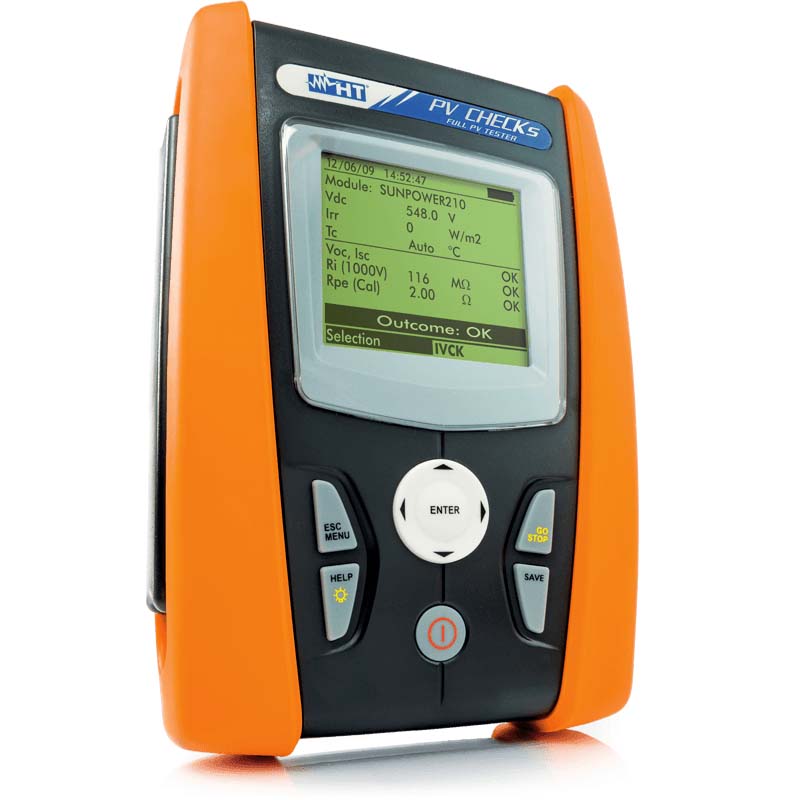
A photovoltaic (PV) system is reliant on solar radiation to produce sufficient energy, and this is the desired output of the PV system design. It is therefore important to measure the performance of a PV system to ensure it has been built, installed and is performing to the design specification.
This is essentially what a PV system commissioning is, and it serves a number of purposes:
- To measure the PV system performance
- To ensure the operation of the system will lead to a longevity in components and equipment
- For compliance in terms of safety and warranties
What is involved in commissioning a PV system?
For grid-connected systems, reference to the British Standard “BS EN 2446 - Grid connected PV systems – minimum requirements for system documentation, commissioning and inspection” is the best way to understand what is required in initial verification of a PV system and also periodic verification, the tests specified are as follows:
Insulation Resistance measurement
Open circuit voltage measurement
Short circuit current measurement
Continuity of protective conductors measurement
However, generally speaking there also are three steps to commissioning a PV system, although the first step can be carried out prior to the system being installed and is effectively establishing a baseline figure for what annual or daily energy the system should be capable of producing, ie. the energy potential.
- Measuring the energy potential of a PV system
The potential of a solar resource is determined by its location, and this is influenced by what natural shading is produced which might affect the amount of sunlight the PV system is exposed to, and how many peak hours of sun the system receives. This is known as solar irradiance and is measured in watts per m2.
An engineer can calculate the expected annual production of energy using the power output of the PV cell and multiplying this by the peak sun hours (watts per m2) and taking into account the power losses experienced due to wiring and the invertor. This can produce an annual or daily energy production and therefore enables a baseline reading of what the system ‘should’ produce once it is installed. The engineer can establish whether the system, as currently configured ‘on paper’, would meet the design spec and therefore can make the necessary adjustments prior to installation.
- Measuring the PV performance
This is carried out once the PV system is installed and acts to determine whether the system is operating as designed. To do this we would look at measuring the relationship between the current and voltage (I-V) in a system by producing a solar I-V curve. The solar I-V curve is a graphical representation of how the PV system is performing in its existing conditions. The graph provides the information required for engineers to configure the PV system so that it operates to its optimum potential, ie. the design spec and energy performance established in step one above. So again, does the PV system meet the design spec?
- Troubleshooting – diagnosing issues and addressing them
So if the PV system output doesn’t meet the desired levels, you need to identify why this is and what adjustments can be made. Typical issues could be if the open circuit voltage or short circuit voltage is higher or lower than it should be, or if the power output is low. Where there is this mis-match in performance compared to the design spec expectations, the engineer can carry out testing to identify or replace modules in the system accordingly, using a range of solar PV test instruments.
Who would carry out PV system commissioning?
PV system commissioning is a staple process of any PV system installation, and should be directed by building owners, facilities managers or engineering managers, but will be carried out by qualified electrical engineers or installation engineers.
Why is PV system commissioning important?
Essentially, commissioning a PV system ensures that it meets the design spec. A PV system can be a significant investment and justification for this is usually measured in terms of pay-back, ie. how many years of energy savings will be experienced before the initial investment is paid back. So it is very important that the system works to spec straight away and pay-back can be measured, and this is the primary purpose of a PV system commissioning. This will ultimately save time and money on installation and operating issues, ensures the design spec is suitable for the operation and environment you have and builds confidence in the system.
So commissioning a PV system is important for many different reasons:
- Confirms the PV system will meet its performance goals
- Demonstrates how the system performs
- Realises the full potential and capacity of the system if initial problems are encountered
- Ensures the design contractors are accountable
- It delivers the desired energy savings straight away.
Please note that this section is for information purposes only. Anyone using equipment referred to in this section must be suitably qualified and/or experienced within the respective field. If in doubt before use, please consult a qualified electrician or engineer & thoroughly read all instruction booklets.